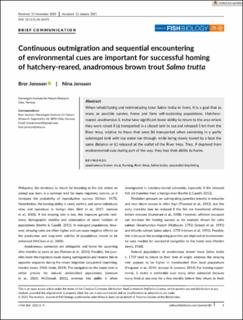Continuous outmigration and sequential encountering of environmental cues are important for successful homing of hatchery-reared, anadromous brown trout Salmo trutta
Peer reviewed, Journal article
Published version

Åpne
Permanent lenke
https://hdl.handle.net/11250/2987087Utgivelsesdato
2021Metadata
Vis full innførselSamlinger
- Publikasjoner fra CRIStin - NINA [2364]
- Scientific publications [1392]
Originalversjon
10.1111/jfb.14673Sammendrag
When rehabilitating and reintroducing trout Salmo trutta in rivers, it is a goal that as many as possible survive, home and form self-sustaining populations. Hatcheryreared, anadromous S. trutta have significant lower ability to return to the area where they were raised if (a) transported in a closed tank to sea and released 5 km from the River Imsa, relative to those that were (b) transported when swimming in a partly submerged tank with sea water run-through, while being slowly towed by a boat the same distance or (c) released at the outlet of the River Imsa. Thus, if deprived from environmental cues during part of the way, they lose their ability to home. anadromous brown trout, homing, River Imsa, Salmo trutta, sequential imprinting
